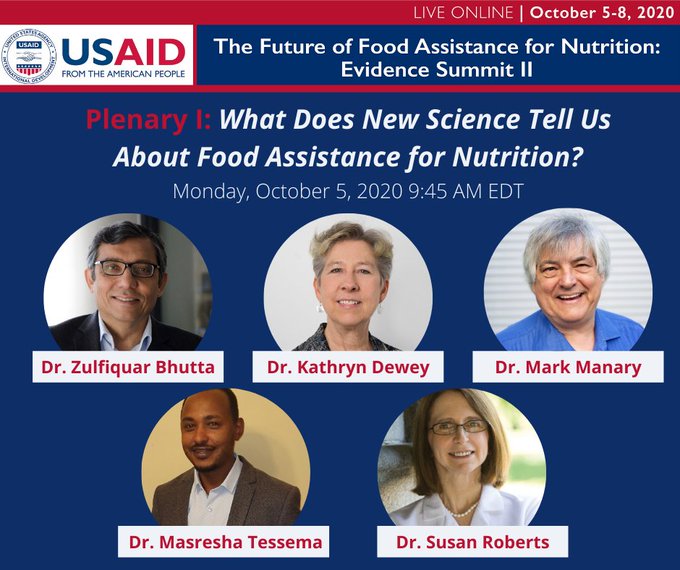5-8 October 2020. The Future of Food Assistance for Nutrition: Evidence Summit II. Organised by the USAID’s Bureau for Humanitarian Assistance and the Food Aid Quality Review project managed byt he Friedman School of Nutrition Science and Policy at Tufts University.
This Summit showcased new findings from studies around the world, covering key food assistance for nutrition themes, including:
- Impacts of pandemics and other disease outbreaks on programming and supply chain logistics;
- Recent advances in science related to nutrition and specialized nutritious food products; and
- How to improve programming.
5 October
Plenary I: What Does New Science Tell Us about Food Assistance for Nutrition? This plenary bridged recent scientific discoveries with considerations for programming and policy to help define the future of food assistance for nutrition. This discussion detailed possible biological and environmental mechanisms that underlie deficits in the growth and development of children due to malnutrition. Highlighted topics included enteric health and the gut microbiome, as well as cognitive development of young children in the presence of acute malnutrition.This session focused on the emerging evidence base for simplified/integrated approaches for the treatment of child wasting along the spectrum of acute malnutrition. It highlighted recent research on the importance of a focus on preventive approaches for children at risk of growth faltering, the use of combined protocols, and related strategic priorities outlined in the UN Global Action Plan on Child Wasting.
6 October
This session reviewed the current scientific evidence and programming implications related to micronutrients and animal source foods for nutrition, including fortification of food aid products to address micronutrient deficiencies, lipid-based nutrient supplements, and using animal source foods to meet nutrient needs.
Panel 2: Packaging of Food Assistance Products: Challenges and Outlook
This session will review new and ongoing challenges related to packaging for food aid products, including efforts to make packaging more environmentally sustainable and packaging solutions for extending the shelf life and for reducing infestation and waste of food aid products.
This session covered recent advancements in alternative formulations for food assistance for nutrition products used for treatment of acute malnutrition. The discussion defined alternative therapeutic foods, provide an overview of the various formulations for specialized nutritious foods (SNFs) that have been scientifically evaluated in recent years, discuss alternative protein sources to be considered in SNFs, and cover details regarding specific novel formulations. This discussion will conclude with implications for programming and policy.
Plenary III: Implications of Treatment and Prevention of Malnutrition Strategies for Food Assistance Programming
This plenary bridged recent scientific discoveries with considerations for programming and policy to help define the future of food assistance for nutrition. This discussion detailed possible biological mechanisms that underlie deficits in the growth of children due to malnutrition. Highlighted topics will include enteric health and the gut microbiome, as well as cognitive development of young children in the presence of acute malnutrition.
7 October
Panel 4: Food Safety and Naturally Occurring Contaminants in Food Assistance ProductsThis session reviewed food safety concerns related to naturally occurring contaminants that can be introduced into food aid products at the raw materials stage, during manufacturing, and throughout the supply chain for these products. This discussion highlighted the importance of evolving food safety measures and of addressing inconsistencies in the current evidence base.
This session will explore recent technological and programming advances related to optimizing the supply chains for food aid products and improving the ability of suppliers, donors, and implementing partners to track and trace products throughout those supply chains.
This session will explore the design and integration of complementary program activities in programming for food assistance for nutrition, with an emphasis on emerging evidence on best practices for nutrition outcome optimization in nutrition-sensitive, systems-level approaches.
This session will review challenges related to disruptions in the supply chain for food aid products faced during previous pandemics and disease outbreaks and how lessons learned can be applied to the current COVID-19 crisis, as well as adaptations in programming for food assistance for nutrition in response to COVID-19.
8 October
This session will attempt to synthesize key information that participants will have been exposed to over the course of the Summit and will also focus on gaps in the current evidence base related to programming for food assistance for nutrition, which will lead into the final working sessions of the event in which we will discuss how to collaborate to begin addressing these gaps.



No comments:
Post a Comment